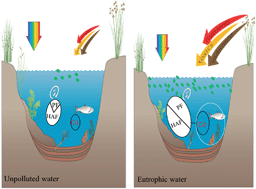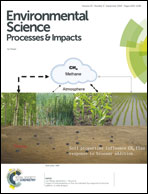Effects of elevated production of autochthonous dissolved organic matter on the freely dissolved concentration of cadmium†
Abstract
Eutrophication enhances the production of autochthonous dissolved organic matter (DOM), which is a major driving factor behind the impairment of many aquatic ecosystems. In a mesocosm study, we investigated the effects of the abundance and composition of DOM on the potential bioavailability of cadmium (Cd) caused by eutrophication, using three-dimensional excitation–emission matrix fluorescence spectroscopy integrated with tangential flow ultrafiltration technology. The complexing capacity of DOM–Cd and the sorption distribution coefficient between DOM and the bulk solution was calculated based on a 1 : 1 complexation model. The fluorescent DOM was decomposed into three components (one protein-like and two humic-like substances) by parallel factor analysis (PARAFAC). The fluorescence intensity of the protein-like substance was significantly correlated with the concentration of chlorophyll a (Chl-a), indicating that the protein-like substance mainly originated from the release or decomposition of algal cells. The complexing capacity of DOM–Cd decreased from 997 μmol Cd per gram dissolved organic carbon (DOC) to 884 μmol Cd per gram DOC with an increase in the proportion of autochthonous protein-like substances. However, the total Cd-complexing capacity of DOM was still high during the algal bloom due to the increase of DOM abundance. The proportion of freely dissolved concentration of Cd to total Cd concentration decreased from 50% to 20%, suggesting that the potential bioavailability of Cd was reduced.



 Please wait while we load your content...
Please wait while we load your content...